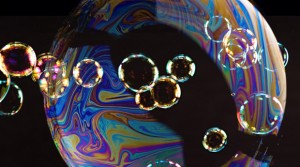
- A Bubble Gets Its Color From Iridescence: As waves of light pass through the bubble, it gets distorted by reflecting off different layers of soap film.
- You Can Freeze Bubbles: A bubble’s shell is composed of a layer of water molecules surrounded by two thin layers of soap. Technically, a bubble will freeze below 32 degrees Fahrenheit like all water. The only problem is that bubbles tend to burst after a few seconds, so in order to see a bubble freeze, the temperature needs to fall to a temperature that will freeze water molecules more quickly.
- Why Do Bubbles Burst?: Anything that fractures the tenuous layer of water molecules can cause a bubble to burst. For example, a gust of wind or an object (like your finger) will easily cause a bubble to burst. Also, a bubble will burst if enough of the water molecules evaporate.
- Many Bubbles Makes A Foam: When many bubbles are joined together, it becomes a foam. From cappuccinos to the foam on the top of your beer, bubbles are all around us.
Thanks to our friends at Gazillion Bubbles for the heads up… Bubbles are loved the world over by people of all ages. There’s even a Gazillion Bubble Show in New York City (http://gazillionbubbleshow.

